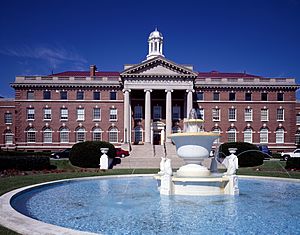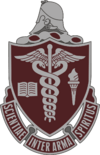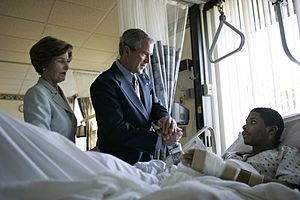Walter Reed Army Medical Center facts for kids
Quick facts for kids Walter Reed Army Medical Center |
|
|---|---|

Walter Reed Medical Center's Building 1 prior to its 2011 closing
|
|
| Founded | 1 May 1909 |
| Country | |
| Branch | |
| Type | Hospital |
| Role | Militarized healthcare |
| Motto(s) | "We Provide Warrior Care" |
| Disbanded | 27 August 2011 |
| Commanders | |
| Notable commanders |
LTG Kevin C. Kiley (2002 – June 2004; 1–2 March 2007) MG Kenneth L. Farmer Jr. (June 2004 – 25 Aug. 2006) MG. George W. Weightman (25 Aug. 2006 – 1 March 2007) MG Carla Hawley-Bowland (final commander) |
| Walter Reed Army Medical Center | |
|---|---|
| Walter Reed Health Care System | |

The WRAMC distinctive unit insignia
|
|
| Geography | |
| Location | 6900 Georgia Avenue NW, Washington, D.C., United States |
| Coordinates | 38°58′30″N 77°01′48″W / 38.975°N 77.03°W |
| Organization | |
| Care system | Military |
| Hospital type | General |
| History | |
| Founded | 1 May 1909 |
The Walter Reed Army Medical Center (WRAMC) was a very important hospital for the U.S. Army. It was the main medical center from 1909 to 2011. Located in Washington, D.C., it covered about 113 acres.
This hospital helped over 150,000 active and retired military members. These patients came from all parts of the United States Armed Forces. The center was named after Walter Reed. He was a U.S. Army doctor and sergeant. Dr. Reed led a team that found out how yellow fever spreads. They proved it was carried by mosquitoes, not by touching people.
Over the years, the hospital grew a lot. It started with beds for 80 patients. By the time it closed, it had about 5,500 rooms. These rooms covered more than 28 acres of floor space. In 2011, WRAMC joined with another hospital. It combined with the National Naval Medical Center in Bethesda, Maryland. Together, they formed the new Walter Reed National Military Medical Center (WRNMMC). The old WRAMC campus is now being turned into a new area called the Parks at Walter Reed.
Contents
History of Walter Reed Hospital
Early Days at Fort McNair
The story of Walter Reed Army Medical Center began at Fort Lesley J. McNair. This fort is in Washington, D.C. It is one of the oldest U.S. Army bases still in use. George Washington himself set aside the land for military use.
Fort McNair is located where the Anacostia River and the Potomac River meet. This made it a great spot to defend the nation's capital. The fort has been around since 1791. It was once a place to store weapons. It also held the first U.S. Federal Prison from 1839 to 1862.
Today, Fort McNair is known as a center for defense ideas. It also has beautiful views of the water. The old health clinic at Fort McNair was the first version of Walter Reed Army Medical Center. Important officials often chose this clinic for their health care.
Walter Reed's Connection to the Clinic
The health clinic at Fort McNair was called "Walter Reed's Clinic." From 1898 to 1909, it was the General Hospital at what was then Washington Barracks. This was before the fort was renamed in honor of Lt. Gen. McNair. This hospital was the start of Walter Reed General Hospital.
The old clinic building is still there. It is a very important military medical building. It is believed that Walter Reed lived and worked there. He was assigned as Camp Surgeon from 1881 to 1882. Later, he returned as a professor and curator. He did some of his important work on diseases at Washington Barracks. He is most famous for finding out how yellow fever spreads. In 1902, Major Reed had surgery there for appendicitis. Sadly, he died from problems after the surgery in that very hospital.
Hospital Training and Relocation
Since the 1890s, the health clinic trained doctors, corpsmen (medical assistants), and nurses. They learned how to provide military health care. In 1899, a building for the morgue was built. This building now holds the Dental Clinic. In 1901, the hospital became its own separate military unit.
Eight years later, in 1909, this new unit moved. They used horse-drawn wagons and an early steam-powered ambulance. They moved 11 patients from the 50-bed hospital. They went north to a new 65-bed facility. This new place became the Walter Reed Army Medical Center we know today. The old facility at Fort McNair became a smaller post hospital.
Walter Reed General Hospital and WRAMC's Growth
The U.S. Congress approved money to build Walter Reed General Hospital. They provided $192,000 for its construction. The company Marah & Peter designed the building. Cramp & Company won the contract to build it. Construction started in 1907.
The first ten patients were admitted on May 1, 1909. Lieutenant Colonel William Cline Borden was key to making the Medical Center happen. Because of his hard work, the facility was nicknamed "Borden's Dream."
In 1923, General John J. Pershing signed an order. This order created the "Army Medical Center" (AMC) on the same campus. At this time, the Army Medical School moved there. It became the "Medical Department Professional Service School" (MDPSS) in the new Building 40. General Pershing lived at Walter Reed from 1944 until he died there in 1948.
In September 1951, a new order combined the WRGH with the AMC. The whole group of 100 rose-brick buildings was renamed. It became the "Walter Reed Army Medical Center" (WRAMC). In June 1955, the Armed Forces Institute of Pathology (AFIP) moved into a new building. In November, the MDPSS was renamed the Walter Reed Army Institute of Research (WRAIR). In 1964, the Walter Reed Army Institute of Nursing (WRAIN) was created. Former President Dwight D. Eisenhower died at WRAMC on March 28, 1969.
A large new WRAMC building (Building 2) was built starting in 1972. It was ready by 1977. The WRAIR moved to a new facility in Maryland in 1999. This was at the WRAMC Forest Glen Annex. Later, Building 40 was planned to be updated by a private company.
In 2007, WRAMC partnered with the University of Pennsylvania. This partnership made special proton therapy available. This treatment helped U.S. military personnel and veterans. It was offered at the Perelman Center for Advanced Medicine.
WRAMC's Closure in 2011

On May 13, 2005, the Department of Defense made an announcement. They suggested replacing Walter Reed Army Medical Center. The plan was to build a new Walter Reed National Military Medical Center (WRNMMC). This new center would be at the National Naval Medical Center in Bethesda, Maryland. This location was about seven miles from the old WRAMC.
This plan was part of a program to combine military medical facilities. The new center would have staff from the Army, Navy, and Air Force. On August 25, 2005, the BRAC Committee approved the plans. The move of services from the old WRAMC to the new one happened slowly. This was to make sure patients still received good care. Thousands of service members, retired personnel, and their families depended on WRAMC.
Operations at the WRAMC facility ended on August 27, 2011. The Army stated that the cost of closing the hospital and combining it with the Bethesda Naval Medical Center more than doubled. It went from the original estimate to $2.6 billion.
Other Organizations at WRAMC
Besides the main hospital, the WRAMC campus hosted other important groups. These organizations worked closely with the hospital.
- The North Atlantic Regional Medical Command
- The North Atlantic Regional Dental Command
- The Armed Forces Institute of Pathology (AFIP)
- The Uniformed Services University of the Health Sciences (USUHS)
- United States Army Institute of Dental Research (USAIDR)
- The DOD Deployment Health Clinical Center
- The National Museum of Health and Medicine (NMHM) was in the same building as the AFIP. The NMHM later moved. It reopened on September 15, 2011, at Fort Detrick Forest Glen Annex in Silver Spring, Maryland.
- The Borden Institute, which focused on military medical research and education.
- The Walter Reed Army Institute of Research (WRAIR) was once in Building 40. This research institute moved to WRAMC's Forest Glen Annex in 1999. In 2008, control of the Annex went to Fort Detrick. This was done to prepare for WRAMC's move in 2011.
Commanding Officers
After 1992, officers from any part of the Army Medical Department could lead medical facilities. However, every commander of the Walter Reed Army Medical Center was a member of the Army Medical Corps (doctors).
Leaders of Walter Reed Army Medical Center
| Image | Rank | Name | Begin date | End date | Notes |
|---|---|---|---|---|---|
 |
Major General | Carla G. Hawley-Bowland | December 2007 | 29 July 2011 | She was the last commander. |
 |
Major General | Eric B. Schoomaker | March 2007 | November 2007 | Later became the Surgeon General of the Army. |
 |
Lieutenant General | Kevin C. Kiley | 1 March 2007 | 2 March 2007 | Also served as Surgeon General of the Army at the same time. |
 |
Major General | George W. Weightman | August 2006 | 1 March 2007 | |
 |
Major General | Kenneth L. Farmer Jr. | June 2004 | August 2006 | |
 |
Major General | Kevin C. Kiley | June 2002 | June 2004 | Later became the Surgeon General of the Army. |
 |
Major General | Harold L. Timboe | May 1999 | June 2002 | |
 |
Major General | Leslie M. Burger | November 1996 | May 1999 | |
 |
Major General | Ronald R. Blanck | October 1992 | October 1996 | Later became the Surgeon General of the Army. |
 |
Major General | Richard D. Cameron | May 1989 | October 1992 | Later Commanding General, United States Army Health Services Command. |
 |
Colonel | James E. Hastings | March 1989 | May 1989 | |
 |
Major General | James H. Rumbaugh | August 1988 | March 1989 | Died while in command. |
 |
Major General | Louis A. Malogne | June 1983 | August 1988 | Retired for medical reasons; died shortly after. |
 |
Major General | Enrique Méndez Jr. | October 1981 | June 1983 | Later Assistant Secretary of Defense (Health Affairs). |
 |
Major General | Bernard T. Mittemeyer | June 1980 | September 1981 | Later became the Surgeon General of the Army. |
 |
Major General | George I. Baker | March 1978 | June 1980 | |
 |
Major General | Robert Bernstein | June 1973 | February 1978 | Previously Command Surgeon in Vietnam. |
 |
Major General | William H. Moncrief | May 1972 | April 1973 | |
 |
Brigadier General | William H. Meroney | April 1972 | May 1972 | |
 |
Major General | Colin F. Vorder Brugge | January 1971 | March 1972 | |
 |
Major General | Carl W. Hughes | November 1970 | January 1971 | |
 |
Major General | Glenn J. Collins | June 1969 | October 1970 | Previously Commanding General of the 44th Medical Brigade. |
 |
Major General | Phillip W. Mallory | May 1967 | June 1969 | |
 |
Major General | Douglas O. Kendrick | June 1965 | March 1967 | |
 |
Major General | Achilles L. Tynes | September 1962 | May 1965 | |
 |
Major General | Clinton S. Lyter | May 1961 | September 1962 | |
 |
Major General | C. F. St. John | July 1959 | April 1961 | |
 |
Major General | Leonard D. Heaton | April 1953 | June 1959 | Later became the Surgeon General of the Army. |
 |
Major General | Paul H. Streit | September 1951 | March 1953 |
Leaders of The Army Medical Center
Leaders of Walter Reed General Hospital
| Image | Rank | Name | Begin date | End date | Notes |
|---|---|---|---|---|---|
 |
Brigadier General | James D. Glennan | March 1919 | March 1926 | |
 |
Colonel | Edward R. Schreiner | August 1918 | March 1919 | |
 |
Colonel | Willard F. Truby | November 1917 | August 1918 | |
 |
Colonel | Charles P. Mason | October 1916 | November 1917 | |
 |
Major | Percy M. Ashburn | September 1915 | October 1916 | |
 |
Colonel | John L. Phillips | May 1914 | September 1915 | |
 |
Colonel | Henry C. "Pinky" Fisher | August 1913 | May 1914 | |
 |
Colonel | H. P. Birmingham | October 1912 | May 1913 | |
 |
Colonel | Charles Richard | September 1911 | September 1912 | |
 |
Colonel | William H. Arthur | 1 June 1908 | 11 July 1911 | He worked with Major Walter Reed in the 1890s. |
Images for kids
See also
- List of former United States Army medical units
- National Register of Historic Places listings in the upper NW Quadrant of Washington, D.C.


































